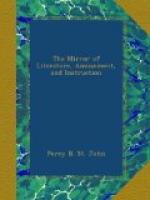THE MIRROR OF LITERATURE, AMUSEMENT, AND INSTRUCTION.
Vol. 17, No. 483.] Saturday, April 2, 1831. [Price 2d.
* * * * *
[Illustration: Grotto at Ascot place.]
Here is a picturesque contrivance of Art to embellish Nature. We have seen many such labours, but none with more satisfaction than the Grotto at Ascot Place.
This estate is in the county of Surrey, five miles south-east from Windsor, on the side of Ascot Heath, near Winkfield. The residence was erected by Andrew Lindergreen, Esq.; at whose death it was sold to Daniel Agace, Esq., who has evinced considerable taste in the arrangement of the grounds. The house is of brick, with wings. On the adjoining lawn, a circular Corinthian temple produces a very pleasing effect. The gem of the estate is, however, the above Grotto, which is situate at the end of a canal running through the grounds. Upon this labour of leisure much expense and good taste have been bestowed. It consists of four rooms, but one only, for the refreshing pastime of tea drinking, appears to be completed. It is almost entirely covered with a white spar, intermixed with curious and unique specimens of polished pebbles and petrifactions. The ceiling is ornamented with pendants of the same material; and the whole, when under the influence of a strong sun, has an almost magical effect. These and other decorations of the same grounds were executed by a person named Turnbull, who was employed here for several years by Mr. Agace. Our View is copied from one of a series of engravings by Mr. Hakewill, the ingenious architect; these illustrations being supplementary to that gentleman’s quarto History of Windsor.
We request the reader to enjoy with us the delightful repose—the cool and calm retreat—of the Engraving. Be he never so indifferent a lover of Nature, he must admire its picturesque beauty; or be he never so enthusiastic, he must regard with pleasure the ingenuity of the artist. To an amateur, the pursuit of decorating grounds is one of the most interesting and intellectual amusements of retirement. We have worshipped from dewy morn till dusky eve in rustic temples and “cool grots,” and have sometimes aided in their construction. The roots, limbs, and trunks of trees, and straw or reeds, are all the materials required to build these hallowed and hallowing shrines. We call them hallowing, because they are either built, or directed to be built, in adoration of the beauties of Nature; who, in turn, mantles them with endless varieties of lichens and mosses. In the Rookery adjoining John Evelyn’s “Wotton” were many such temples dedicated to sylvan deities: one of them, to Pan, consists of a pediment supported by four rough trunks of trees, the walls being of moss and laths, and enclosed with tortuous limbs. Beneath the pediment is the following apposite line from Virgil:




